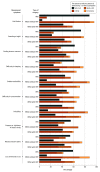Association of Salpingectomy With Delayed Oophorectomy Versus Salpingo-oophorectomy With Quality of Life in BRCA1/2 Pathogenic Variant Carriers: A Nonrandomized Controlled Trial
- PMID: 34081085
- PMCID: PMC8176392
- DOI: 10.1001/jamaoncol.2021.1590
Association of Salpingectomy With Delayed Oophorectomy Versus Salpingo-oophorectomy With Quality of Life in BRCA1/2 Pathogenic Variant Carriers: A Nonrandomized Controlled Trial
Abstract
Importance: Most women with a BRCA1/2 pathogenic variant undergo premature menopause with potential short- and long-term morbidity due to the current method of ovarian carcinoma prevention: risk-reducing salpingo-oophorectomy (RRSO). Because the fallopian tubes play a key role in ovarian cancer pathogenesis, salpingectomy with delayed oophorectomy may be a novel risk-reducing strategy with benefits of delaying menopause.
Objective: To compare menopause-related quality of life after risk-reducing salpingectomy (RRS) with delayed oophorectomy with RRSO in carriers of the BRCA1/2 pathogenic variant.
Design, setting, and participants: A multicenter nonrandomized controlled preference trial (TUBA study), with patient recruitment between January 16, 2015, and November 7, 2019, and follow-up at 3 and 12 months after surgery was conducted in all Dutch university hospitals and a few large general hospitals. In the Netherlands, RRSO is predominantly performed in these hospitals. Patients at the clinical genetics or gynecology department between the ages of 25 and 40 years (BRCA1) or 25 to 45 years (BRCA2) who were premenopausal, had completed childbearing, and were undergoing no current treatment for cancer were eligible.
Interventions: Risk-reducing salpingo-oophorectomy at currently recommended age or RRS after completed childbearing with delayed oophorectomy. After RRSO was performed, hormone replacement therapy was recommended for women without contraindications.
Main outcomes and measures: Menopause-related quality of life as assessed by the Greene Climacteric Scale, with a higher scale sum (range, 0-63) representing more climacteric symptoms. Secondary outcomes were health-related quality of life, sexual functioning and distress, cancer worry, decisional regret, and surgical outcomes.
Results: A total of 577 women (mean [SD] age, 37.2 [3.5] years) were enrolled: 297 (51.5%) were pathogenic BRCA1 variant carriers and 280 (48.5%) were BRCA2 pathogenic variant carriers. At the time of analysis, 394 patients had undergone RRS and 154 had undergone RRSO. Without hormone replacement therapy, the adjusted mean increase from the baseline score on the Greene Climacteric Scale was 6.7 (95% CI, 5.0-8.4; P < .001) points higher during 1 year after RRSO than after RRS. After RRSO with hormone replacement therapy, the difference was 3.6 points (95% CI, 2.3-4.8; P < .001) compared with RRS.
Conclusions and relevance: Results of this nonrandomized controlled trial suggest that patients have better menopause-related quality of life after RRS than after RRSO, regardless of hormone replacement therapy. An international follow-up study is currently evaluating the oncologic safety of this therapy.
Trial registration: ClinicalTrials.gov Identifier: NCT02321228.
Conflict of interest statement
Figures



Similar articles
-
Risk-reducing salpingectomy with delayed oophorectomy to prevent ovarian cancer in women with an increased inherited risk: insights into an alternative strategy.Fam Cancer. 2024 Nov;23(4):437-445. doi: 10.1007/s10689-024-00412-0. Epub 2024 Jun 21. Fam Cancer. 2024. PMID: 38907139 Free PMC article. Review.
-
Salpingectomy With Delayed Oophorectomy Versus Salpingo-Oophorectomy in BRCA1/2 Carriers: Three-Year Outcomes of a Prospective Preference Trial.BJOG. 2025 May;132(6):782-794. doi: 10.1111/1471-0528.18075. Epub 2025 Jan 17. BJOG. 2025. PMID: 39823150 Free PMC article.
-
TUBectomy with delayed oophorectomy as an alternative to risk-reducing salpingo-oophorectomy in high-risk women to assess the safety of prevention: the TUBA-WISP II study protocol.Int J Gynecol Cancer. 2023 Jun 5;33(6):982-987. doi: 10.1136/ijgc-2023-004377. Int J Gynecol Cancer. 2023. PMID: 37045546 Free PMC article.
-
Early salpingectomy (TUbectomy) with delayed oophorectomy to improve quality of life as alternative for risk-reducing salpingo-oophorectomy in BRCA1/2 mutation carriers (TUBA study): a prospective non-randomised multicentre study.BMC Cancer. 2015 Aug 19;15:593. doi: 10.1186/s12885-015-1597-y. BMC Cancer. 2015. PMID: 26286255 Free PMC article. Clinical Trial.
-
Systematic review of acceptability, cardiovascular, neurological, bone health and HRT outcomes following risk reducing surgery in BRCA carriers.Best Pract Res Clin Obstet Gynaecol. 2020 May;65:46-65. doi: 10.1016/j.bpobgyn.2020.01.006. Epub 2020 Feb 4. Best Pract Res Clin Obstet Gynaecol. 2020. PMID: 32192936
Cited by
-
Care after premenopausal risk-reducing salpingo-oophorectomy in high-risk women: Scoping review and international consensus recommendations.BJOG. 2023 Nov;130(12):1437-1450. doi: 10.1111/1471-0528.17511. Epub 2023 May 2. BJOG. 2023. PMID: 37132126 Free PMC article.
-
Psychiatric safety associated with hormone replacement therapy for menopausal symptoms: a real-world study of the FDA adverse event reporting system.Front Psychiatry. 2025 Jun 27;16:1614087. doi: 10.3389/fpsyt.2025.1614087. eCollection 2025. Front Psychiatry. 2025. PMID: 40656051 Free PMC article.
-
Cost-Effectiveness of Gene-Specific Prevention Strategies for Ovarian and Breast Cancer.JAMA Netw Open. 2024 Feb 5;7(2):e2355324. doi: 10.1001/jamanetworkopen.2023.55324. JAMA Netw Open. 2024. PMID: 38334999 Free PMC article.
-
Screening and prevention of ovarian cancer.Med J Aust. 2024 Mar 18;220(5):264-274. doi: 10.5694/mja2.52227. Epub 2024 Feb 14. Med J Aust. 2024. PMID: 38353066 Free PMC article. Review.
-
Risk-reducing salpingectomy with delayed oophorectomy to prevent ovarian cancer in women with an increased inherited risk: insights into an alternative strategy.Fam Cancer. 2024 Nov;23(4):437-445. doi: 10.1007/s10689-024-00412-0. Epub 2024 Jun 21. Fam Cancer. 2024. PMID: 38907139 Free PMC article. Review.
References
-
- Integraal Kankercentrum Nederland. Richtlijn Erfelijk en Familiair Ovariumcarcinoom [Guideline Hereditary and Familial Ovarian Carcinoma]. Published June 1, 2015. Accessed October 6, 2017. https://www.nvog.nl/wp-content/uploads/2018/02/Erfelijk-en-familiair-ova...
Publication types
MeSH terms
Substances
Associated data
LinkOut - more resources
Full Text Sources
Medical
Miscellaneous

